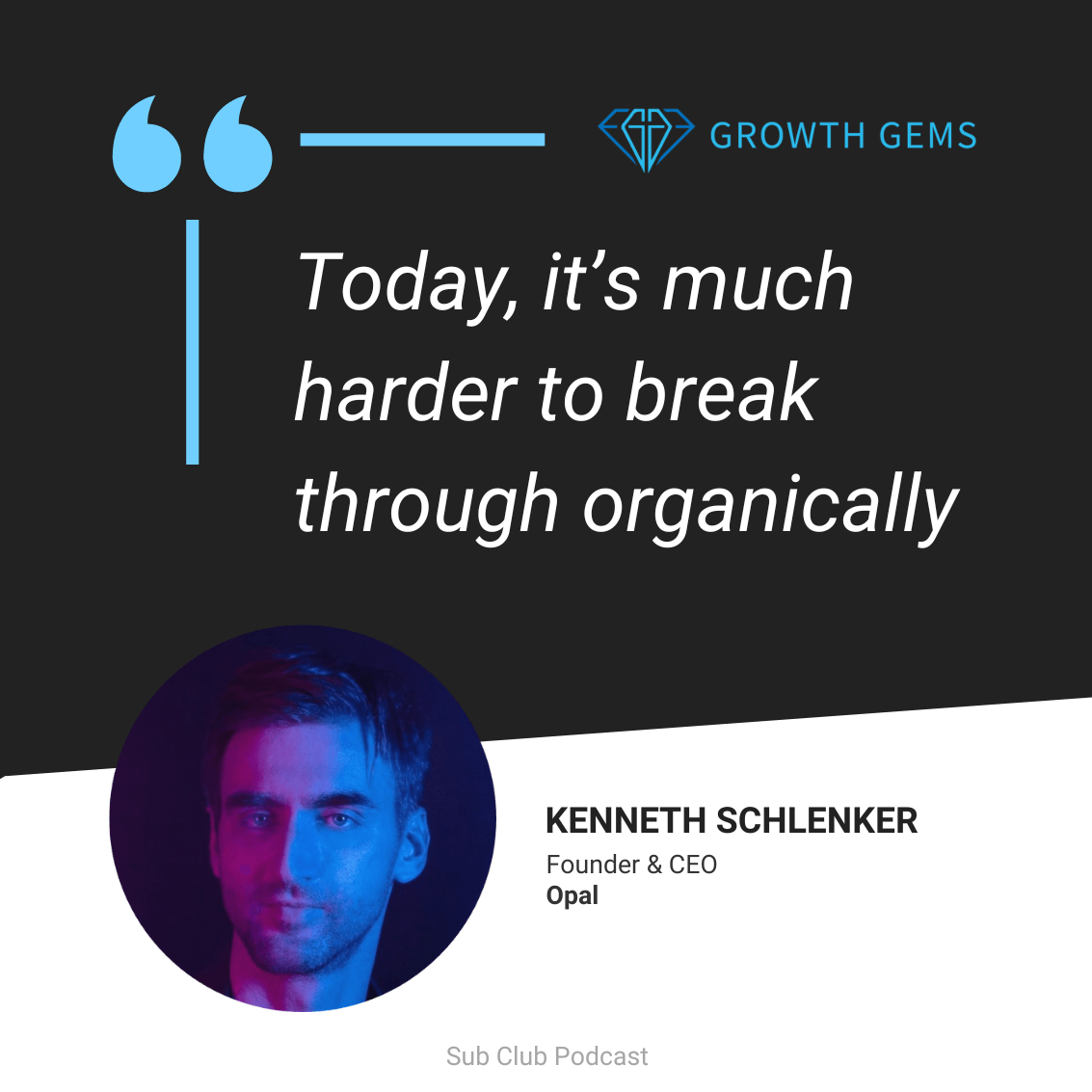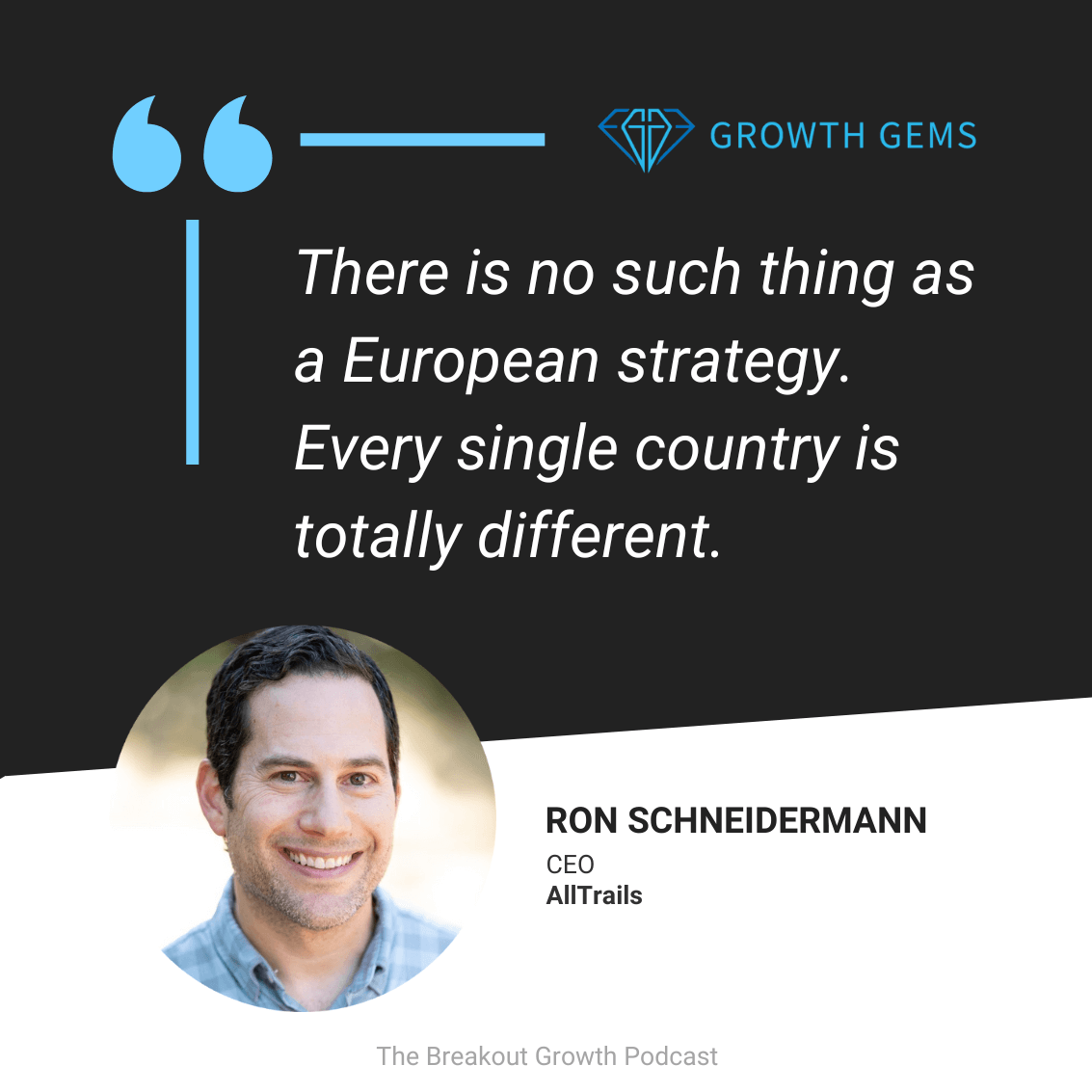Hey,
This week, I’m sharing gems on Subscription Growth & Monetization: the 3 growth phases and A/B testing.
These insights come from Kenneth Schlenker, Jacob Eiting, and Ron Schneidermann.
Enjoy!
🥇 TOP GEM OF THE WEEK
Subscription Growth & Monetization
Gems from Kenneth Schlenker (CEO at Opal) and Jacob Eiting (CEO at RevenueCat) in Lessons from 121 A/B Tests on the Sub Club Podcast
You can’t go wrong with a Sub Club episode.
I use Opal a lot, and I find their approach very interesting.
There are #growthgems for companies at all growth stages in this discussion.
Enjoy!
Growth phases (overview)
💎 Possible growth phases for a subscription business:
Proving the opportunity: people are willing to use the product but also to pay for it. The main metric for this phase: direct blended ROAS
Working on the freemium model (users can start using the product for free), with smaller upsells than a subscription, in order to expand to way more people.
Expanding into other platforms and B2B
(02:23) by Kenneth
Early stage (phase 1)
💎 Early-stage, getting people to pay for your product is a strong signal you have something valuable. Build something good enough for people to pay for first, and figure out who these people are and how you can acquire more of them.
(03:55) by Kenneth
Kenneth mentioned that this is opposite to what other apps like Duolingo and Strava did.
Initially, he thought Opal would be mostly for Gen Z and students. But the people willing to pay were knowledge workers in their 30s- 40s.
This made me think of the Madhavan Ramanujam insights I shared in Growth Gems #85 (and his book): you prioritize your product roadmap based on willingness to pay.
💎 In the early days, you want consistently 100 downloads/day rather than a drip of 1,000 people on a waitlist. Paid acquisition (e.g., Meta) allows you to do that well.
(06:17) by Kenneth
This gives you a clearer read on your changes' impact and allows you to test and optimize for the people you acquire with paid (vs. just early adopters you get organically).
💎 One way to increase your testing velocity is to force yourself to release app versions at a specific frequency so you create an experiment rhythm (could be small or bigger experiments). Example: Opal had a 1 version per week schedule.
(06:35) by Kenneth
💎 If you price relatively high toward the beginning (e.g., Opal started at $69/year then raised to $100/year) and aim for 100% blended D7 ROAS (if you have a 7-day free trial), you can re-invest quickly into advertising.
(08:13) by Kenneth
Kenneth mentioned that initially, they were not at 100% ROAS, but they did feel like they had a path to it.
This quote makes me want to say, “Yes, but…” but I’ll follow the words of Yoann Pavy on this one and say, “F*** Nuances.”
💎 You can complement your attribution setup with a How Did You Hear Survey? It allows you to segment by answer to estimate channel-level ROAS.
(12:00) by Kenneth
The freemium model (phase 2)
💎 Subscriptions typically hit a growth ceiling at one point (e.g., 10-30 MRR). Working on a freemium model helps you anticipate the ceiling many subscription apps hit at one point (e.g., 10-30M MRR). It helps word of mouth to have more people using the product for free, and it’s a lot easier for users to talk to someone else about an app when it’s free.
(19:40) by Kenneth
He mentioned that 17% of their active users are paid subscribers, compared to 7.8% paid penetration for Duolingo.
💎 In phase 2 (freemium model), look at usage retention and ARPU. You want to increase usage retention while having an ARPU that is lower than before but doesn’t go below a certain level (above $2).
(23:40) by Kenneth
Wait! Lowering ARPU?
Kenneth mentions this because a lower ARPU is the strongest signal that you have more free users. But he also looks at usage retention to ensure they are active so they help with word of mouth. Those free users in the app must be a net positive in the long run.
One example he gave of doing this is making it easier to dismiss the onboarding paywall to increase activation. It’s a long-term play that might not work for some categories/apps.
Expansion (Phase 3)
💎 The next growth phase is expansion:
Expanding onto other platforms (e.g., Android, MacOS, etc.)
Expanding in distribution with B2B (companies, schools, etc.)
(26:00) by Kenneth
Opal is still only available on iOS.
💎 Expanding into other platforms, particularly too early, can be a trap. 2 platforms is not 2x the difficulty; it’s 3-4x the difficulty. Revenue is also not linear, and if your product is still evolving, then you end up wasting time.
(27:43) by Jacob
However, Jacob added that a big reason to have an Android app in addition to an iOS app is word of mouth, for when people share it with others.
A/B tests
💎 You need to get the paywall as early as possible in the onboarding, but not too early. What you’re looking for is the peak motivation moments. If this means you need a few screens first, do that.
(33:36) by Kenneth
💎 You should know exactly how you want every person’s first experience to be. You want people to slide down into their first experience while you pitch them and demonstrate the value.
(36:30) by Jacob
Want to get a sense of how Opal onboards users? I recommend downloading the app, or you can check out this post by Johannes von Cramon (App Marketing Consultant).
💎 The less extreme your test is, the longer it’s going to get results (or you might not even get results.) Most of the time, tests are inconclusive, so the bigger swings you take, the better.
(37:44) by Jacob
Kenneth shared they could have done a better job prioritizing the bigger swings and trying to estimate before the test what the uplift could be to do so.
He mentioned some tests that had a major impact, like putting the paywall 2 or 3 screens before.
💎 Identify the main levers of change in your product and teach your entire team (including the engineering team). You need to know what moves the needle and what doesn’t.
(33:36) by Jacob
This is so often overlooked.
It might happen naturally by following what other apps are doing, but you need to understand your own levers.
💎 Offering more choices to people during the onboarding experience can make performance worse. People lead busy lives; they need something very simple, and having an “automatic” action is the best way to do this. Example: the default on Opal is to disconnect 9pm-5am. They tried to provide options, and it performed worse.
(43:05) by Kenneth
💎 It’s hard to make people re-engage with the product if they don’t purchase it right away. What works is detecting trial cancellations and immediately providing an offer.
(44:05) by Kenneth
More gems on subscription growth (international expansion)
Gems from Ron Schneidermann (CEO at AllTrails) in International Expansion as a Growth Lever on The Breakout Growth Podcast
Since Kenneth mentioned the “expansion” phase of subscription growth, and AllTrails was referenced a couple of times, I thought it would be timely to share the insights from AllTrails’ CEO on the topic.
Don’t rush into it!
💎 It’s easy to underestimate how much language support slows down your product development lifecycle (by introducing cardinality): design takes 30% longer, coding, marketing, app store listing. This slows down velocity until you figure out how to operationalize it.
(17:35)
💎 When internationalizing, start small. You can start with localizing for other English-speaking countries first: UK, Australia, New Zealand, etc. Start with smaller things before you commit to the harder localization elements.
(20:50)
💎 There are different product-channel fits depending on the market and different strategies in different markets to generate revenue. Example: some countries don’t like annual renewing subscriptions.
(21:35)
💎 When internationalizing, you need to understand, for each country, where in the funnel you have the most leverage and opportunity and where you’re the weakest.
(24:38)
Ron shared that several things may end up being country-specific: strategy/playbook, funnel, and analytics.
💎 More often than not, it’s not a well-entrenched competitor who is your barrier to growth in a local market. It’s about what you don’t understand and what you’re not delivering yet in terms of product or monetization strategy.
(27:40)
They did have a harder time in Germany because there was an entrenched competitor, but he also mentioned something they understood there (and in Japan): people like local products.
Want to learn more about AllTrails’ content loop and strategy? Check out Kurtis Morrison’s teardown below 👇
Before I leave, here is a quote on onboarding I spotted on LinkedIn:
“If you onboard new users with CAKES, don't off-board them with Anti-Depressant!” - Himaanshu S
See you next time.
Stay curious!
⛏️ Sylvain
🔗 Sources:














Genial!
I saw the interview on YouTube but I really like how you summarized it and added even more great input. Thank you very much!